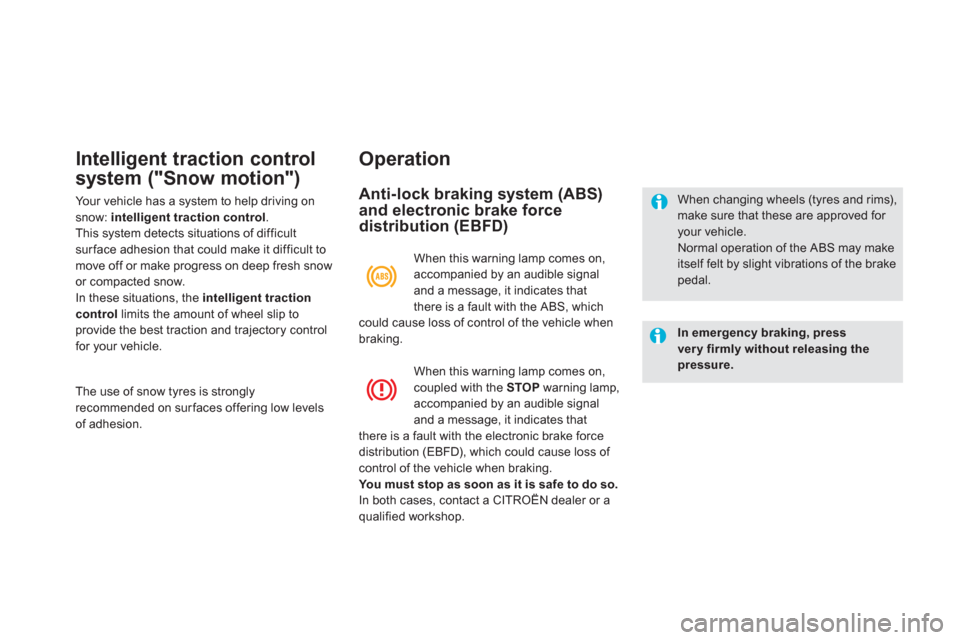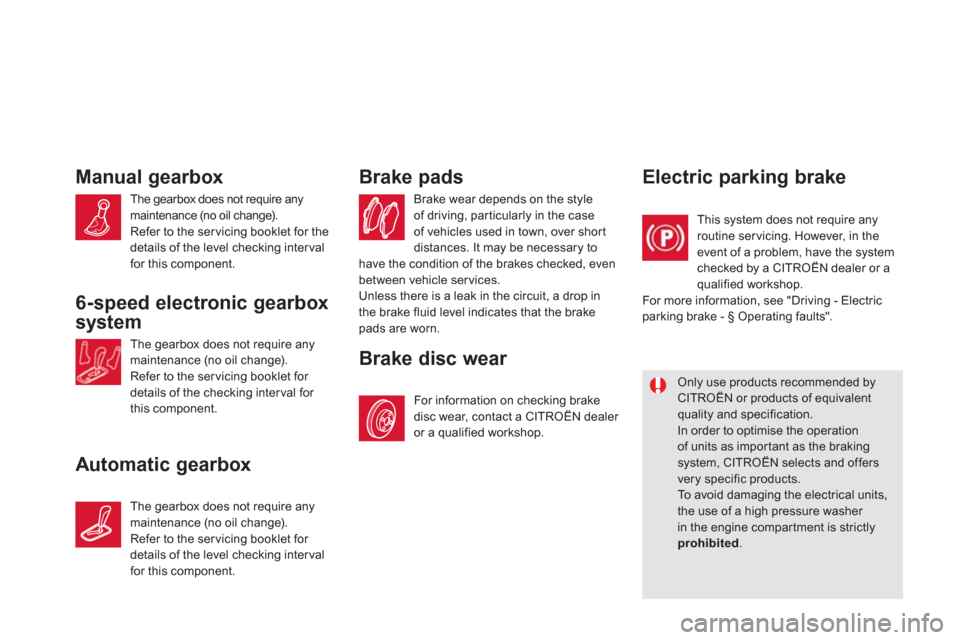Brake fault Citroen DS5 RHD 2011.5 1.G User Guide
[x] Cancel search | Manufacturer: CITROEN, Model Year: 2011.5, Model line: DS5 RHD, Model: Citroen DS5 RHD 2011.5 1.GPages: 348, PDF Size: 10.49 MB
Page 117 of 348

115
Driving
You must press the brake pedal when starting the engine.
Whatever the circumstances, you mustmanually apply the parking brake when parking, unless the parking brake is programmed in automatic mode.
When immobilising the vehicle, with the engine running, you must place the gear lever in neutral N.Before carrying out any work in the engine compar tment, check that the gear lever is in neutral N
and that the parking brake is applied.
Stopping the vehicle
With the ignition on, the flashing of this warning lamp,
accompanied by an audible signal and a message
in the instrument panel screen, indicates a
mal
function of the gearbox.
Have it checked by CITROËN or a qualified
workshop. Be
fore switching off the engine, you canchoose to:
- move to position N
to engage neutral,
- leave the gear engaged; in this case, it will
not be possible to move the vehicle.
In both cases, you should apply the parking brake to immobilise the vehicle.
Operating fault
Sport setting
�)
After selection of manual
or automated mode, press
the Sbutton to switch on the Sport setting, which provides a
more dynamic driving style.S appears alongside the gear engaged in the instrument panelscreen.
�)Press the Sbutton again to switch it off. Sthen disappears from the instrument panel screen.
The Spor t setting is switched off every time the
ignition is switched off.
Page 168 of 348

Ty r e u n d e r - i nfl ation detection System which automatically checks the pressure of the tyres while driving.
Sensors fitted in each valve trigger a warning in
the event of malfunction (speed above 12 mph(20 km/h)).
The spare wheel is not fitted with a sensor.
All repairs and changing of tyres on a wheel fitted with this system must becarried out by a CITROËN dealer or a qualified workshop.
If, when changing a tyre, you install a wheel which is not detected by your vehicle (example: fitting of snow tyres),you must have the system reinitialised by a CITROËN dealer or a qualifiedworkshop.
This message is also displayed whenone of the wheels is away from thevehicle (being repaired) or when one or more wheels without a sensor are fitted.
The tyre under-inflation detectionsystem is an aid to driving which doesnot replace the need for the driver to bevigilant or to drive responsibly.
This system does not avoid the needto have the tyre pressures checkedregularly (refer to "Identification markings") to ensure that the optimumdynamic performance of the vehicle is maintained and prevent premature wear of the tyres, particularly in arduousdriving conditions (heavy load, highspeed). The tyre pressures must be checked cold, at least once a month. Remember to check the pressure of the spare wheel.
The tyre under-inflation detectionsystem may experience temporary inter ference due to electromagnetic signals on a frequency close to thatused by the system.
A message appears in the instrument panel screen, accompanied by an audible signal, to
identify the wheel concerned.
Under-infl ated tyre
This warning lamp andthe STOPwarning lamp come on, accompanied by an audible signal and a message in the
instrument panel screen identifying the wheelconcerned. �)Stop immediately, avoiding any sudden
movement of the steering wheel and the brakes. �) Change the damaged wheel (punctured or
very deflated tyre), and have the tyre pressurechecked as soon as possible.
Puncture
A message appears in the instrument panel
screen, accompanied by an audible signal,
to identi
fy the wheel or wheels which are not
detected or to indicate a fault in the system.
Contact a CITROËN dealer or a qualified
workshop to replace the faulty sensor(s).
Sensor(s) not detected or faulty
�)Check the tyre pressures as soon as possible. This check must be carried out when the tyres are cold.
Page 170 of 348

Intelligent traction control
s
ystem ("Snow motion")
Your vehicle has a system to help driving onsnow: intelligent traction control.This system detects situations of difficult surface adhesion that could make it difficult to move off or make progress on deep fresh snow
or compacted snow.In these situations, the intelligent traction control
limits the amount of wheel slip to provide the best traction and trajectory control
for your vehicle.
Operation
Anti-lock braking system (ABS)
and electronic brake force
distribution
(EBFD)
In emergency braking, press very firmly without releasing the pressure.
When changing wheels (tyres and rims),make sure that these are approved for your vehicle.
Normal operation of the ABS may make itself felt by slight vibrations of the brake pedal. When this warnin
g lamp comes on,
accompanied by an audible signal
and a message, it indicates that
there is a fault with the ABS, which
could cause loss of control of the vehicle whenbraking.
When this warnin
g lamp comes on, coupled with the STOPwarning lamp,
accompanied by an audible signal
and a message, it indicates that
th
ere is a fault with the electronic brake forcedistribution (EBFD), which could cause loss of control of the vehicle when braking.
You must stop as soon as it is safe to do so. In both cases, contact a CITROËN dealer or a qualified workshop. The use o
f snow tyres is strongly recommended on surfaces offering low levels of adhesion.
Page 188 of 348

Changing a wheel Procedure for changing a faulty wheel for the spare wheel using the tools provided with the vehicle.
Th
e tools are installed in the boot under
the floor.
Access to the tools
List of tools
All of these tools are specific to your vehicle and can vary according to the level of equipment. Do not use them for other purposes. 1.
Wheelbrace.
For removing the wheel trim and removingthe wheel bolts. 2.Jack with integral handle.
For raising the vehicle.3."Bolt cover" tool.
For removing the bolt protectors (covers)
on alloy wheels.4. Wheel trim remover.
For removing the alloy wheel finishers.
5. Socket for the security bolts (located in the glove box).
For adapting the wheelbrace to the special"security" bolts.
6.Wheel chocks for blocking the vehicle's
wheels.7. Towing eye.
See "Towing the vehicle". 8.Extension spanner.
For slackening/tightening the spare wheelcarrier nut. 9. Emergency release control for the electric parking brake.
See the "Electric parking brake" section, "Emergency braking".
Tyre under-infl ation detection
The spare wheel is not fitted with a sensor. The punctured wheel must berepaired by a CITROËN dealer or a
qualified workshop.
Page 230 of 348

Manual gearbox
The gearbox does not require anymaintenance (no oil change).
Refer to the ser vicing booklet for the
details of the level checking interval
for this component.
6-speed electronic gearbox
s
ystem
The gearbox does not require anymaintenance (no oil change).
Refer to the servicing booklet for
details of the checking inter val for
this component.
Automatic gearbox
The gearbox does not require any
maintenance (no oil change).
Refer to the servicing booklet for
details of the level checking interval
for this component.Brake wear depends on the style
o
f driving, par ticularly in the case
of vehicles used in town, over shor t
distances. It ma
y be necessary to
have the condition of the brakes checked, even between vehicle services.
Unless there is a leak in the circuit, a drop in
the brake fluid level indicates that the brake pads are worn.
Brake pads
For information on checking brake
disc wear, contact a CITROËN dealer
or a qualified workshop.
Brake disc wear
Electric parking brake
This system does not require any routine servicing. However, in the
event of a problem, have the systemchecked by a CITROËN dealer or a qualified workshop.
For more information, see "Driving - Electric parking brake - § Operating faults".
Only use products recommended by CITROËN or products of equivalent quality and specification.
In order to optimise the operationof units as impor tant as the braking system, CITROËN selects and offersvery specific products.
To a v o i d d a m aging the electrical units,the use of a high pressure washer in the engine compar tment is strictly prohibited .